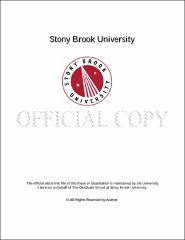| dc.identifier.uri | http://hdl.handle.net/11401/77163 | |
| dc.description.sponsorship | This work is sponsored by the Stony Brook University Graduate School in compliance with the requirements for completion of degree. | en_US |
| dc.format | Monograph | |
| dc.format.medium | Electronic Resource | en_US |
| dc.language.iso | en_US | |
| dc.publisher | The Graduate School, Stony Brook University: Stony Brook, NY. | |
| dc.type | Dissertation | |
| dcterms.abstract | Cancer remains the second leading cause of death in the United States. Traditional chemotherapy relies on highly potent cytotoxic agents, such as paclitaxel and docetaxel, to kill rapidly dividing cancer cells. But these drugs usually cause undesired side-effects due to lack of tumor-selectivity, and decreased efficacy against MDR cancer cell lines. Accordingly, newer generation taxoids were designed and evaluated showing several orders of magnitude greater potency than paclitaxel and docetaxel. Over the past decade, significant advancement has been made on the development of newer generation taxoids based on SAR study. As a selected example of second generation taxoid, SB-T-1214 was synthesized via β-Lactam Synthon Method in good overall yield and enantiomeric purity, and used as cytotoxic agent for taxoid-based drug conjugate synthesis. To elucidate the bioditribution profiles of SB-T-1214, a rapid methylation Pd-catalyzed Stille coupling reaction condition was developed toward C-11 radiolablling SB-T-1214 as PET agent., several unexpected taxoid-based derivatives were found during the cold synthesis, indicating a complicated mechanism for the Pd-Cu co-catalyzed Stille coupling reaction. The LC/UV/MS-TOF methods were fully established to analyze the outcome of Stille coupling reaction confirm the predicted structures by mass analysis. Three new taxoid were synthesized with full characterization. Various taxoid-based tumor-targeted drug delivery systems (TTDDSs) have been developed to efficiently and selectively deliver newer generation taxoid to the tumor microenvironment. Biotin has been utilized as tumor-targeting module (TTM) due to its receptor overexpressed on the surfaces of various cancer cells. Two biotin-linker-taxoid drug conjugates BLS and BLT-S were designed and synthesized, consisting of a biotin as tumor targeting module, a second generation taxoid SB-T-1214 as the warhead, connected with a self-immolative disulfide linker, and/or a polyethylene glycol oligomer for improving solubility and bioavailability. Biological evaluation in vitro and in vivo including internalization study using confocal microscopy and flow cytometry, and cell viability assays against various cell lines exhibited excellent target-specificity of these drug conjugates. To investigate the biodistribution of biotin-bearing conjugates in vivo, a key precursor toward [18F]-labeled biotin diagnostic tracer has been made readily for radio-synthesis. Furthermore, a versatile TTDDS consisting of 1,3,5-triazine as a tripod splitter module, biotin moiety, linker-drug moiety, and a chelating arm for capturing radioisotopes 64Cu/99mTc for PET/SPECT imaging, has been designed to synthesize theranostic drug conjugates. “Cold†synthesis conditions using 65Cu/185Re as surrogates have been optimized to 10 minutes, and separation methods have been well established within 30 minutes. PAMAM (poly(amidoamine)) dendrimer has highly symmetric and well-defined structure. A type of PAMAM dendrimer with cleavable cystamine core was selected to construct a novel and versatile asymmetric bow-tie dendrimer-based (ABTD) platform that was used to synthesize a series of ABTD conjugates via click chemistry. Internalization study demonstrated the multi-binding effect for enhanced cell uptake through receptor-mediated endocytosis (RME). The cell viability assays have shown that this ABTD platform is highly efficient for selectively delivering anticancer drugs to biotin-receptor overexpressing tumor cells and the platform itself is biocompatible. Purification and analysis methods have been well established to isolate nanoscale intermediates as single component in extremely good purity with full characterization. | |
| dcterms.available | 2017-09-20T16:52:08Z | |
| dcterms.contributor | Boon, Elizabeth | en_US |
| dcterms.contributor | Ojima, Iwao | en_US |
| dcterms.contributor | Goroff, Nancy | en_US |
| dcterms.contributor | Sitharaman, Balaji. | en_US |
| dcterms.creator | Wang, Tao | |
| dcterms.dateAccepted | 2017-09-20T16:52:08Z | |
| dcterms.dateSubmitted | 2017-09-20T16:52:08Z | |
| dcterms.description | Department of Chemistry. | en_US |
| dcterms.extent | 484 pg. | en_US |
| dcterms.format | Monograph | |
| dcterms.format | Application/PDF | en_US |
| dcterms.identifier | http://hdl.handle.net/11401/77163 | |
| dcterms.issued | 2015-12-01 | |
| dcterms.language | en_US | |
| dcterms.provenance | Made available in DSpace on 2017-09-20T16:52:08Z (GMT). No. of bitstreams: 1
Wang_grad.sunysb_0771E_12454.pdf: 27531123 bytes, checksum: 4440ef8f575b868e2b1cfe66d4d63f79 (MD5)
Previous issue date: 1 | en |
| dcterms.publisher | The Graduate School, Stony Brook University: Stony Brook, NY. | |
| dcterms.subject | Cancer Biology, Drug Discovery, Nanomedicine, PET/SPECT Imaging, Polymer Chemistry | |
| dcterms.subject | Chemistry | |
| dcterms.title | Design, synthesis, and biological evaluation of novel taxoid-based small-molecule theranostic PET/SPECT imaging agents and nano-scale asymmetric bow-tie dendrimer drug conjugates towards tumor-targeted chemotherapy | |
| dcterms.type | Dissertation | |

